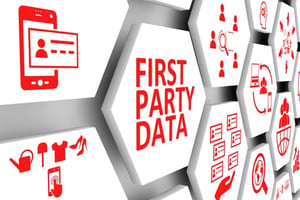Data is continually being traded in today’s world. For marketers, this information is like gold, because it means marketing efforts can be improved through better marketing initiatives. Because of this, many businesses rely on first and third party data. Here’s a look at the key differences between the two and why you need to be using both.
What is First Party Data?
First party data is the data you collect directly from your audience. This information can be collected via your website, your social media platforms, customer feedback surveys, subscription services, and your customer relationship management (CRM) system.
First party data is information given to a company by the customer in a consensual manner via landing pages, online forms, website visits etc. When you’re using a CRM platform, this data will include a person's history on your website in detail.
Since this data is collected directly from the source, it is considered highly valuable to marketers, and taken as high-quality since the data is reliably sourced. It is also freely and easily accessible information which is waiting to be tapped into. Businesses should be collecting, managing, and analyzing this data.
With this data, you can gain insights into the actions, behaviors, characteristics, and interests of your existing audiences. This arms marketers with the ability to personalize adverts and communication, re-target customers effectively, and produce marketing campaigns that are relevant and more precise. Additionally, the data allows for accurate predictions to be made, and better relationships to be fostered. With this, your business will increase its ability to satisfy the audience, improve marketing efforts, and increase revenue.
Is there second party data? Yes. This is first party data collected and sold to another business. However, this data is oftentimes limited due to privacy laws and governing bodies that protect customer data. Therefore, many businesses bypass this and instead rely on first and third party data.
What is Third Party Data?
Third party data is information that is collected by a third party and sold to businesses. These businesses are data providers who work with a large amount of data from various sources, and then aggregating them. This data can include personal information, contact details, and historical actions.
The data is divided into categories for different industries, so businesses can approach them for data on certain segments of the market that are relevant to their business.
Third party data is therefore rapidly collected and analyzed on a large scale. Businesses who buy this data accept that it is anonymously supplied in the sense that the original sources remain unknown. It is also not exclusively available, meaning your competitors have the same access to that information if they purchase it as well.
This data is often collected in a number of ways, including declared data (consensually provided information), inferred insights (by studying a particular segment), and observed data (which is collected through tracking). This data can be collected in various ways too, including websites, social media platforms, surveys, and subscriptions. These various sources are then brought together, analyzed, and sold to businesses.
So, why do businesses need third party data? Well, it can be a great source of marketing context, demonstrating key insights into the market at large. With this, you can expand your audience and reach accordingly. It also adds the element of scale to your marketing research, meaning you can improve your overall targeting. This data is also unbiased and more generalized, which makes it a good source of information to use in conjunction with first party data.
When consulting with a third party data provider, you need to consider their reputation as data providers, their compliance with privacy laws, and the test data that they provide as a sample of the data they will provide you with when working with them.
Differences in Data

First and third party data are different in terms of scale and source. Marketers who use both sets of data to research their audiences are able to develop strong marketing campaigns with more success, since their understanding of the target market is improved. While the data is different, they should be collected, organized, and analyzed by businesses in conjunction. This way, you’ll have comprehensive research and customer profiles to work with.
Using First and Third Party Data
Marketers will be well-equipped to develop in-depth and accurate buyer personas when incorporating the data from both first and third party sources. These different sets of data can improve your targeting efforts and increase your audience and revenue.
Need help collecting first party data?
Nexa is a digital marketing agency based in Dubai. We can help you to collect, manage, and store data from your audience. Our marketing team can also help you to draw key insights from this data, and develop highly targeted marketing campaigns. Book an obligation-free session with us to get started.
%20(1).png?width=2701&height=607&name=BRC_NEXA_LOGO_BLACK%20%26%20VIOLET%20(1)%20(1).png)
%20(1).png?width=2701&height=607&name=BRC_NEXA_LOGO_WHITE%20(2)%20(1).png)















Comments